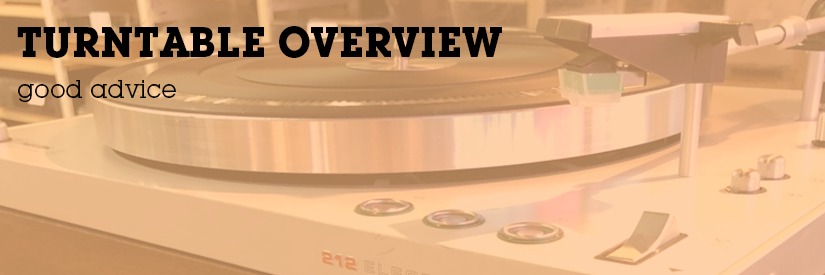Turntable Overview
- Posted on

What makes a turntable? Here is an overview of the basic components of every deck. Once you've whet your appetite for knowledge with the basics, follow the links on the right for even more delicious detail.
First you have the CHASSIS
[the body of the turntable]
- plinth (the body of the table)
- suspension (vibration isolation)
- platter (the round bit that spins)
- motor (why it spins)
- platter bearing (supports the platter and allows it to spin with minimal friction)
Next stop, TONEARM
[the pivoting or sliding arm that holds the cartridge and moves across the record]
- bearing (allows the arm to pivot on two axes with little friction but held rigidly)
- counterweight (sets the balance of the arm)
- arm wand (the long tube)
- head shell (often detachable structure on the end of the arm wand containing the wires and mounting point for the cartridge)
- tracking force adjustment (often part of the counterweight, controls force between the stylus and record)
- anti-skate/bias (a very small force pulling the cartridge end of the arm towards the outside of the record to center the cartridge in the groove. The cart. naturally puts more pressure on the inner wall of the groove, bias corrects that)
Finally, CARTRIDGE
[the small box mounted to the head shell that reads the musical information in the groove and turns it into an electrical signal]
- cartridge body (the box and mounting points)
- motor (in some way a magnet(s) and coils of wire to transform vibration into electricity, microphones, guitar pickups and speakers operate on similar principles.)
- cantilever (the small rod emerging from the underside of the cart. to which is attached. . .)
- the stylus (the actual pointy bit of diamond that rides in the groove of the record) sometimes stylus refers to the entire replaceable cantilever/stylus assembly on moving magnet carts.
Incidentally, before we continue, that sliver of diamond travels nearly half a mile, endures severe resonance and intense contact temperatures as it plays one side of an LP. The scale may be small but the stresses are immense. We'll get to how they're dealt with later on.
The above list is a fairly simple breakdown of what goes on inside an LP player. We're going to take it one section at a time beginning with CHASSIS and get into specifics as we go. We're not getting into esoteric audiophile stuff, this info applies to any decent turntable! Just remember, let your ears guide you and the more records you play, the happier you'll be.
